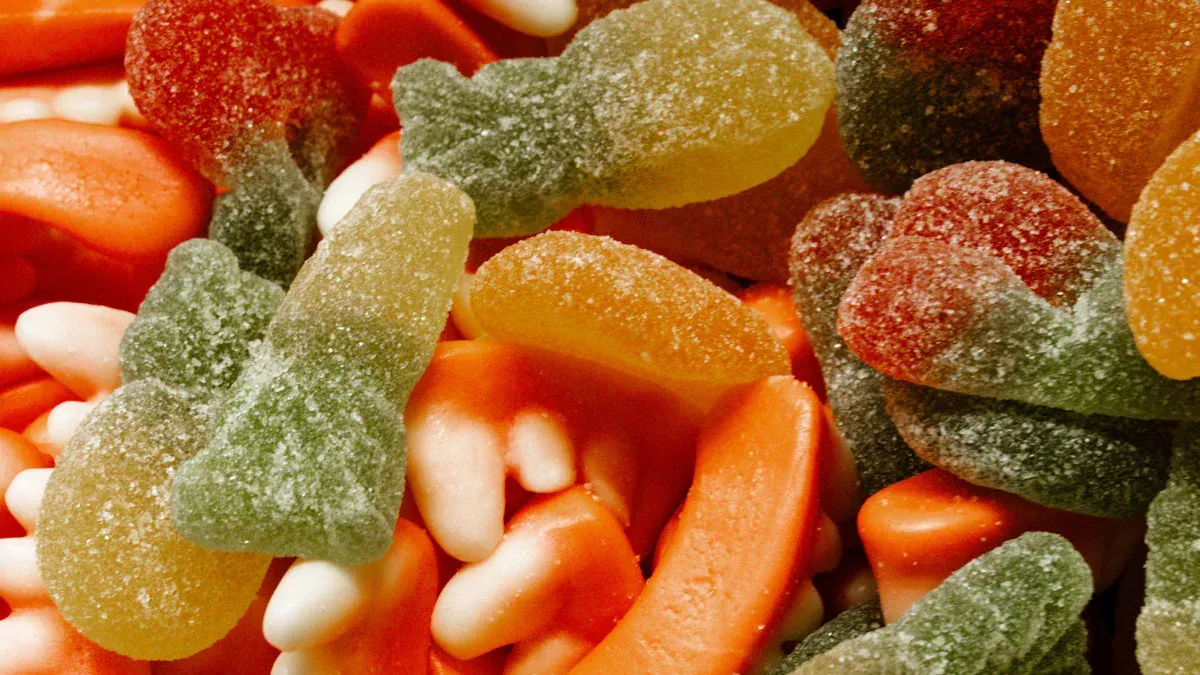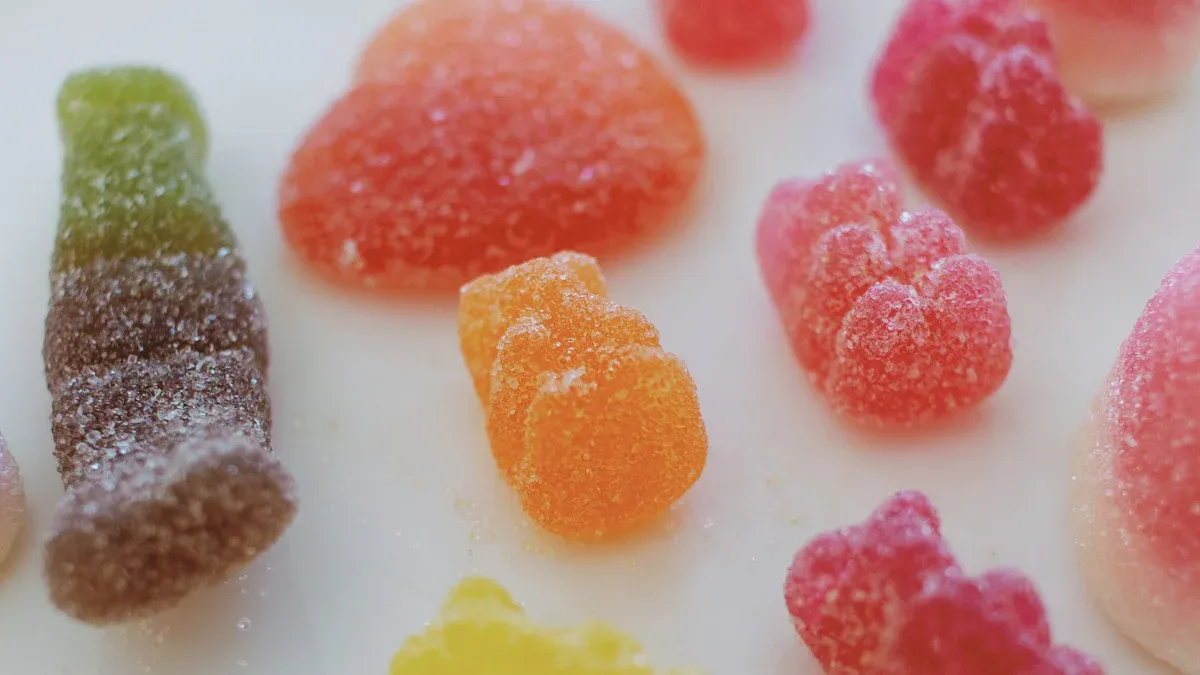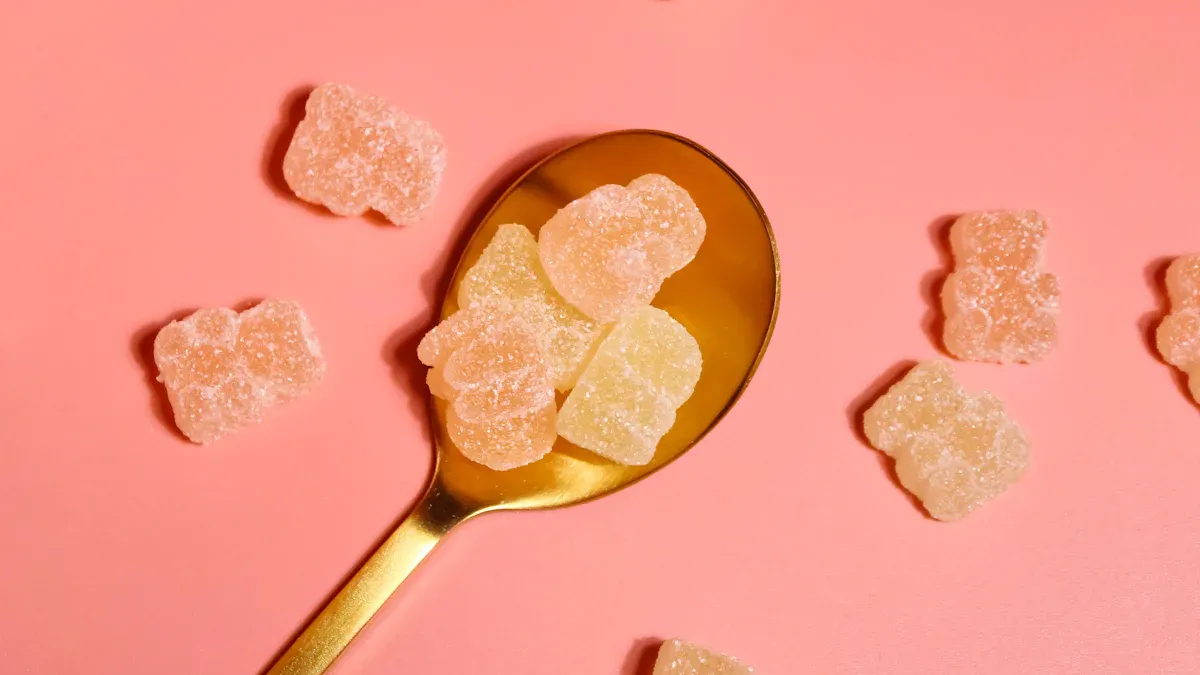








You taste gummies as acidic because makers add food acids like citric and malic acid. These acids make gummies acidic, giving gummy candy a tangy flavor and balancing out the sweetness. This makes each bite more enjoyable. The acids also help keep gummies fresh and improve their texture. Acids activate the gelling agents, which give gummies their chewy feel.
Tip: If you have sensitive teeth or kids who love gummies, remember that gummies acidic can wear down tooth enamel over time.
Gummies taste sour because they have food acids like citric, malic, and tartaric acid. These acids make the flavor stronger and help the texture feel better.
Acids keep gummies fresh by making the pH lower. This stops bacteria and mold from growing. It helps gummies last longer on the shelf.
To make gummies less acidic, use less citric acid. You can also change the amount of sugar. Try using other things like fruit juices instead.

Gummy candy tastes tangy because it has acids mixed in. The most common acids in gummies are citric acid, malic acid, and tartaric acid. Each acid adds something different to the candy.
Citric acid is used a lot in gummy candy. You taste it in almost every fruity gummy. This acid makes flavors taste stronger and brighter. It also helps gummies get the right chewy texture. Citric acid helps gummies stay soft and not too hard.
Malic acid gives sour gummies their strong, puckering taste. It makes the sour flavor feel natural, like a green apple. Malic acid helps gummies keep their shape and keeps the pH steady. This means sour gummies stay chewy and fresh for longer.
Tartaric acid is in some gummies for extra tartness. You might taste it in grape or citrus gummies. It works with other acids to make gummies taste more tangy. Tartaric acid also helps gummies gel and get their chewy feel. It is used for special flavors in gummy candy.
Sour gummies often have a layer of acid crystals on them. This coating gives you a quick sour taste when you bite. Makers sometimes use encapsulated acids for these coatings. Encapsulation helps the sour flavor last longer and keeps gummies fresh. Studies show encapsulated acids help gummies keep their sour taste and chewy texture for months. This method also slows down sugar breakdown, so sour gummies stay tasty and chewy.
Note: Sour gummies have more acid than other candies. This extra acid makes the flavor stronger but can change the gummy’s texture over time.
You may wonder why gummies taste sour. The reason is how gummies are made. Makers add acids like citric, malic, or tartaric acid. These acids do more than make gummies tangy. They help gelling agents work well. Pectin needs acid to form a gel. When the pH is between 3.0 and 3.5, pectin makes gummies chewy. This step is needed for the texture in acid gummy bears and sour treats.
Acids make fruity flavors stronger in gummies.
They set the pH for pectin to gel and shape the texture.
The pH also affects how fast gummies set and how firm they feel.
You notice acids at work every time you eat a chewy gummy.
Texture makes gummies fun to eat. Acids help gelling agents do their job. Adding citric or malic acid helps pectin or gelatin form a network. This network holds water and sugar. That gives acid gummy bears their bounce and chew. To see how acidic gummies are made, check the pH. The best pH for gelation is between 3 and 5. If the pH is too high or low, the texture changes.
Here is how pH affects gummy texture:
pH Level | Gel Strength | Hardness | Chewiness | Springiness | Cohesiveness |
|---|---|---|---|---|---|
4 | Low | Low | Low | Moderate | Moderate |
5 | High | High | High | High | High |
6 | Highest | Highest | Highest | High | High |
7 | Moderate | Moderate | Moderate | Moderate | Moderate |
8 | Low | Low | Low | Low | Low |
9 | Very Low | Very Low | Very Low | Very Low | Very Low |
10 | Very Low | Very Low | Very Low | Very Low | Very Low |
The right pH gives gummies the best chew and firmness. Acids also mix with other ingredients. Citric and malic acids can make the gelatin network weaker. Adding pectin or agar-agar makes the structure stronger. Inulin, a plant fiber, helps the gel network stay stable.
Gummies acidic taste good and last longer. The sour flavor comes from acids, but acids also keep gummies safe. Lowering the pH stops bacteria and mold from growing. Most gummies have a pH between 3.15 and 5.00. This keeps them safe and fresh.
Aspect | Findings |
|---|---|
pH Levels | pH values of gummy candies range from 3.15 to 5.00, crucial for microbial control. |
Water Activity | Water activity values (0.66 to 0.74) help prevent spoilage. |
Microbial Agents | Yeasts and molds are main spoilage agents in low humidity foods. |
Stability | Gummies with the right pH have low microbial counts and longer shelf life. |
Makers use encapsulated acids to keep sour flavor strong and shelf life long. Encapsulation protects acids so they release slowly. This stops clumping, keeps flavor fresh, and stops moisture from ruining gummies.
Encapsulated acids give a strong sour taste.
They lower pH and stop bacteria from growing.
Barrier materials in encapsulation keep moisture out.
You want your sour gummy to taste just right. Makers balance acids and sugars carefully. They test recipes to get the best mix. They follow safety rules like USDA Organic guidelines. At least 95% of ingredients must be certified organic. Regular tests check for contaminants and keep gummies safe.
Quality control keeps sourness and safety right.
Choosing ingredients matters for taste and health.
Testing and rules protect you and your family.
If you ask how acidic gummies are made tasty and safe, the answer is balance. Makers balance acids, sugars, and gelling agents. This gives you the tangy taste, chewy bite, and freshness in your favorite gummies.
Tip: If you make gummies at home, measure acids carefully. Too much acid makes gummies too soft or sour. Too little, and they may not gel or stay fresh.

Sometimes, you want gummies to taste less sour. This can be for health or flavor reasons. Many people at home ask how to do this. They want to keep the chewy feel but make gummies less acidic. Food scientists have some easy tips:
Use less citric acid in your recipe. This makes the pH go up and gummies taste less sour.
Make sure you have the right amount of sugar. The sugar level, called Brix, helps control how sour gummies are and keeps them chewy.
Pay attention to how long and hot you cook gummies. Use a good scale and thermometer to help you get it right.
Tip: If you add something new to your recipe, check the pH again. Some things can change how acidic gummies are, so you might need to use more or less citric acid.
You can use other things to make gummies less acidic. Some people use fruit juice that is not very sour, like pear or peach juice. They use these instead of lemon or lime juice. Others add calcium or magnesium salts. These help gummies gel without adding more acid. Trying new things can change how gummies taste and feel, so make a small batch first.
A table can help you see your choices:
Ingredient | Effect on Acidity | Impact on Texture |
|---|---|---|
Pear Juice | Lowers acidity | Softer |
Calcium Salts | Neutral | Firmer |
Less Citric Acid | Raises pH | May be less chewy |
If you want gummies with no acid, you have options. Some recipes use only gelatin, sugar, and flavor. These gummies taste sweet but not sour. But gummies with less acid can have problems with how long they last:
Gummies can soak up water and stick together.
They can dry out and get hard if the air is dry.
If it gets too hot, gelatin gummies can melt and lose their shape.
If you use less sugar, gummies can get sticky or change texture.
Note: Kids usually like sour gummies more than adults. Studies say about 35% of kids like the sourest gummies, but most adults do not.
Gummy candy tastes tangy and chewy. It also lasts a long time. Acids make gummies sour and help keep them safe:
Sour gummies have a pH under 4.0. This makes them taste very sour. It can also hurt your teeth.
Lots of acid keeps gummies fresh. It stops germs from growing.
If you want gummies with less acid, you have choices:
Customization Aspect | Description |
|---|---|
Ingredients | You can use less acidic things for a softer taste. |
Flavors | You can change flavors to make gummies less sour. |
Labels and Packaging | You can pick packaging that you like best. |
You can buy or make gummies that fit what you want and need.
Gummies taste sour because makers add food acids. These acids make the flavor stronger. They also help the texture. Acids keep gummies safe while being made.
Gummies usually have citric, malic, and tartaric acids. These acids give gummies their sour taste. They also help acid gummy bears stay chewy.
Factories use special machines to make gummies. Makers mix acids, sugar, and gelling agents together. This gives each batch the right taste and feel.
Copyright © 2023 Foshan Xingle Machinery Equipment Co.,Ltd. 粤ICP备2023093194号 All rights reserved. Privacy Policy | Sitemap | Support By Leadong